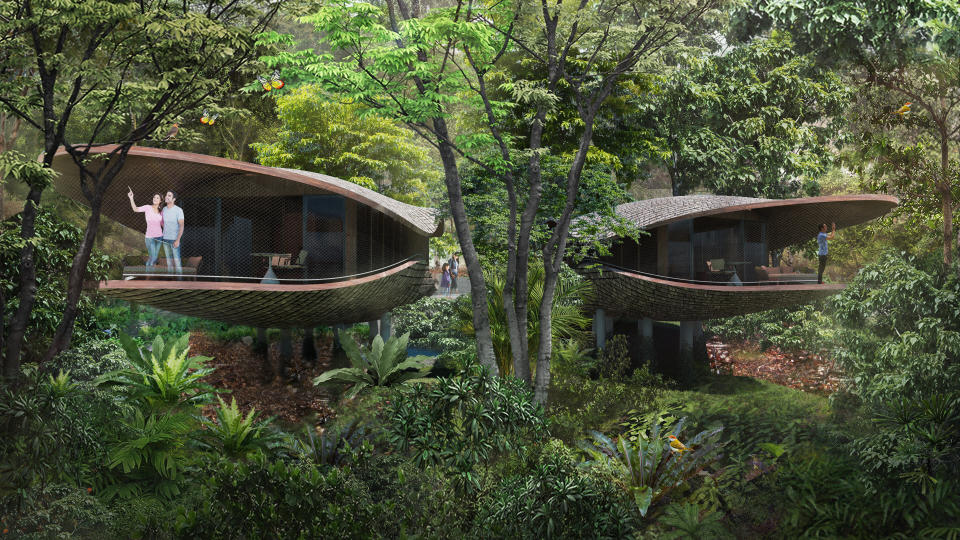Coming in 2023: Banyan Tree’s first Singapore resort will be eco-friendly Mandai development

SINGAPORE — Banyan Tree Holdings’ first Singapore resort will feature 338 rooms and eco-friendly features on a 4.6 hectare site at the eastern end of the Mandai Precinct.
This includes 24 elevated tree houses, shaped like seed-pods and nestled amongst trees surrounding the resort. The holiday destination, set to open in 2023, will be operated by Banyan Tree and owned by Mandai Park Holdings (MPH).
READ MORE:
The world's 50 best honeymoon hotels and destinations
Live your best life: Supparetreat is a wellness retreat that aims to positively change your mindset
Aperitif injects creativity into Ubud's dining scene
Helming its design is local architecture firm WOW Architects, winner of MPH’s design competition for the resort. The firm aims to make it the first Super Low Energy (SLE) resort in Singapore by incorporating measures such as the use of natural ventilation and solar panels.
During a media briefing at the Wildlife Reserves Singapore’s Singapore Zoo on Thursday (23 May), MPH CEO Mike Barclay said the accommodation will allow visitors to fully explore the attractions of the Mandai Precinct, a process that takes two to three days.
Guests at the resort will also enjoy curated programmes, including nature walks, conservation talks and behind the scenes tours. One example would be working with keepers at night to prepare food for a particular animal and then returning in the morning to watch it feed.

Hopefully, they “will leave as excited as us about wildlife, and as determined as us to protect animals in the wild”, added Barclay.
Ho Kwon Ping, executive chairman of Bayan Tree, stressed that the resort will allow visitors “unprecedented access” to nature.
“It is truly a contribution to all Singaporeans who do not have the opportunity to go to distant countries and interact with nature,” said Ho.
Minimising environmental impact
More than half the trees on the site will be retained, of which 40 per cent are of high conservation value, in addition to extensive planting at the roof and facade of the resort buildings, said WOW Architects’ managing director Wong Chiu Man.
When the resort is completed, the site is expected to have twice the number of trees, he added.
“The site would be in far better condition than it is right now,” said Wong.
As part of energy savings, almost half of the resort’s roofs will be fixed with solar cells. There will be skylight openings to bring in natural light and enhance air movement in corridors which will not be air conditioned, noted Wong.
The 24 tree houses will also feature passive displacement ventilation, which cools air using chilled water rather than traditional air-conditioning.

Meanwhile, guests will be encouraged to reduce energy and water consumption in their rooms, to practice recycling and to dispose their food waste responsibly.
As the various stakeholders wanted to minimise the resort’s impact on nature, they decided on having 338 rooms across buildings clustered in areas where trees have already been cleared, he said. It is even elevated four metres above the ground, wherever possible, to allow native wildlife to move across the site, with its height capped at 21 metres to respect existing tree lines.
Before working on a site, the MPH does a series of shepherding exercises for terrestrial animals and extensive surveys for rare animals, said Barclay, in response to a question on the additional precautions taken.
Over 1,000 cases of injured animals are treated by the parks’ vets and released back into the wild per year, he added.
Barclay declined to reveal the budget for the resort, noting that it remains subjected to competitive tendering. But he pointed out that an unencumbered site of the same size in the city centre could hold a building with 1,000 rooms.

On the pricing of the rooms, Ho said that “they have not thought about it yet”.
“We will further stretch the affordability by also having camping strategies - we will have sites with prefixed frames, ceiling fans and bed structures,” added Barclay. “We will also have free camping opportunities.”
The resort, which has yet to be officially named, is part of an ambitious rejuvenation project expected to attract more than 10 million visitors each year, said the MPH at the launch of its construction phase in 2017.
The project includes the relocation of Jurong Bird Park and the development of a new Rainforest Park in the same area as the Singapore Zoo, Night Safari and River Safari.
The Bird Park and the new Rainforest Park are scheduled to open by 2020 and 2021 respectively.
The rejuvenated Mandai Precinct is expected to generate 400 more jobs in conservation research, tourism and hospitality.

